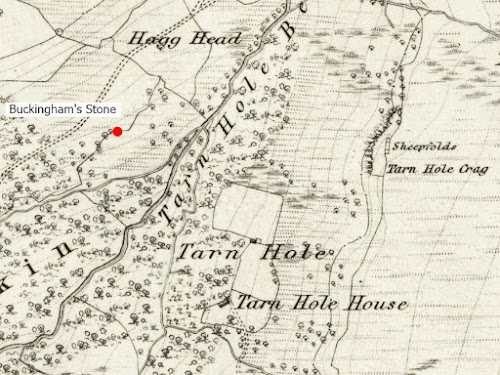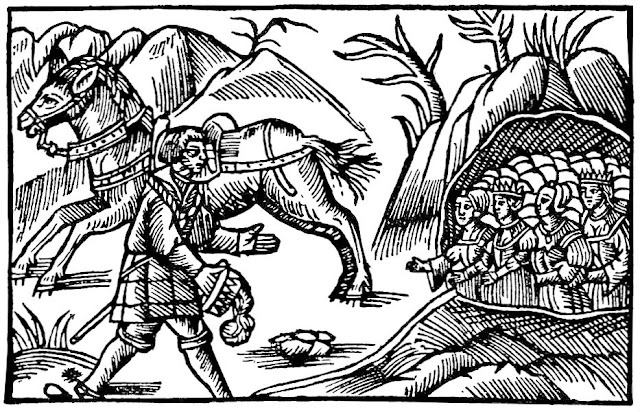
|
|
Erdmänneken - (Schmidt, 1873) |
(As pointed out in the
Buckingham Stone
post last year, Tarn Hole is privately owned land, and not part of the open
access area just to the north.)
Tarn Hole is a large wooded valley on the edge of East Bilsdale Moor, two miles to the south-east of Chop Gate on the North York Moors.
At one time this valley was home to the Tarn Hole Hob, although next to nothing is known about this secretive little fella. A Hob is a supernatural dwarf-like being, recorded in folklore across the North York Moors and other parts of Northern England. (See the Hob-Thrush of Over Silton). Unfortunately, all we have is the Tarn Hole Hob name, which appeared in a list made in the early 1800's by George Calvert of Pickering (Home, 1905). In this list he noted all the Hobs he had heard about on the North York Moors. At one time there would have been a local story to explain the Hob's connection with Tarn Hole, but it was not written down, and so the folklore has been lost.

|
| OS map (1857) Map credit NLS |
The Tarn Hole name seems to have been attached to a quite isolated area towards the head of the valley, on its east side. Here, the first edition OS map (1857) marks 'Tarn Hole' and Tarn Hole House, alongside 3 fields enclosed by drystone walls. Above the fields, on the top edge of the valley side, there is a section of rock outcrop called Tarn Hole Crags. In folklore, Hobs are usually attached to a specific place - often a farm, but they were believed to actually live in rocky places, as was the case at Over Silton. The Tarn Hole Hob name might point to this Hob being connected with Tarn Hole House, and perhaps dwelling in the nearby crags (also see the Scugdale Fairy Butter Tree.)
The Runswick Bay Hob lived in a cave in the cliffs on the sea shore. Jenny of Biggarsdale was also described as a Hob, and was said to live in a cave in the rock face beside a waterfall. There are no details about the Hob of Hasty Bank, but this is another hill with rock outcrops, including the impressive Wain Stones. The Hob of Hob Hole (Baysdale) had some connection with a large boulder on the hillside there, which was also linked to a giant in local legend. As well as being linked with cliffs, crags and stones in some way, it also seems that the Hobs were believed to have healing powers. The hob of Runswick Bay was visited with requests to cure illness, while there is a possibility the Hasty Bank Hob may have been connected with a healing spring. The large rock at Hob Hole was used as a platform from which women performed a folk ritual to request an easy birth and healthy children.
Back at Tarn Hole, we have no details about the Hob except the name, which probably connects him with Tarn Hole House and perhaps the crags 200m away. However, 200m in the opposite direction stands Buckingham's Stone - a large boulder balanced on top of a raised rock 'platform'. Is it possible that the Tarn Hole Hob was actually connected with this unusual rock feature?

|
|
Buckingham's Stone and a wee chap |
John Fairfax-Blakeborough (1907) mentions that "some" dales folk
say Buckingham's Stone was rolled into its present position to mark the site
where the Duke of Buckingham's horse died at the end of a long hunt. The horse
died of exhaustion and was apparently buried there sometime in the late
1600's. On seeing the size and position of this large boulder it is hard to
believe that anyone would go to such an effort just to mark where a horse was
buried -if indeed it was possible to raise the boulder by man power alone. It
is perhaps more likely that the rock ended up in this position naturally,
either being glacially deposited, or a 'fluke' landing spot for a rock
tumbling down the hillside above. If this was the case then the boulder may
have also been a Rocking Stone, as there are now stones placed beneath it to
stop any movement. Rocking Stones, being unusual features in the landscape,
often have folklore attached to them. Some are said to be boulders thrown by
giants, others were regarded as sites capable of healing illnesses such as
rickets, where babies and young children were placed on the stone and rocked.
As noted above, Buckingham's Stone was named after the second Duke of Buckingham - George Villiers. The Dukes hedonistic lifestyle had left him in poor health in later life, and he eventually retired to Helmsley castle, from where he pursued his love of hunting up until his death in 1687. There are several stories about the duke hunting in Bilsdale, and he is said to have died after catching a chill while either waiting for a fox to be dug out, or for a fresh horse to be brought to him - possibly after his horse died in Tarn Hole. The real cause of his death seems to have not been made public, and was officially recorded as pneumonia, however a letter from his friend at that time (lord Arran) indicates that he actually died from an infection and gangrene in his 'private parts'.
The duke had been part of the 'Merry Gang' at the royal court of James II, who were notorious for their drinking and lewd debauchery. One description of Buckingham mentions that he was "...infamous for his licentiousness, in which he is so wrapped up that there is no sex, nor age, nor condition of persons who are spared from it". Diseased 'privates' are the likely consequence of such a lifestyle, and although he had the services of the best doctors, there is a tradition that he also visited a healing spring near Aberford (Buckingham's Well) to try and cure his Ague.Bringing these elements together at Tarn Hole, we have the dwelling place of a supernatural Hob -known for their healing powers. The location of an unusual boulder/Rocking Stone (also known to be used for healing rituals), and an old duke in poor health, willing to try folk remedies. Is it possible that the duke was at the Tarn Hole stone for reasons other than hunting?

|
|
King Hodor seeks help from the supernatural Maidens (Magnus, 1550) |
There were no doctors for the poorer people in society at that time, so they
had to rely on home remedies, and when these failed they would consult the
local wiseman or woman. The duke was unusual in that he mixed with 'commoners'
through his hunting activities, and so he may well have had access to a local
folk healer in this way. With doctors unable to help the duke, he may have
been advised to visit the Tarn Hole Hob and request a cure for his illness,
just as people did in Runswick Bay. To push this speculation further, there
are records from elsewhere in Britain at this time, of animals still been
sacrificed in order to cure illness. For example, a bull was sacrificed by a
man at Loch Maree near Inverness in 1695, in an attempt to cure his sick
daughter. In such cases a bull would be their most valuable possession.
Elsewhere, cows were buried alive in the hope of curing murrain in a herd. The
story of the dukes best horse been buried at the Tarn Hole stone may be a
vague or disguised description of such an event, by a desperate duke whose
health was failing. Although this can only be speculation, it would not be an
unknown occurrence in those days. Such an activity would not be made public
for obvious reasons, just as the real cause of the Duke's death was apparently
concealed.
One final piece of information may link the Tarn Hole Hob directly with
Buckingham's stone. Elsewhere in Britain there are a number of Rocking Stones
called the 'Buck Stone', and this seems to have been an alternative name for
such stones - derived from the Old English 'Būg-stān'. Middle English Bugge
and welsh Bwg were both words for a Hob-goblin. So it is possible to make a
case that the Tarn Hole boulder was originally a Rocking Stone known locally
as the 'Buck Stone'. This name in itself meaning the Hob (goblin) Stone
probably explains the source of the healing powers believed to be associated
with rocking stones. From here it is only a a short step for the Buck Stone to
become Buckingham's Stone, either from an actual visit made by the duke, or
even as a later piece of folk etymology.
After thoughts
The Buck Stone name highlights a folklore contradiction noted elsewhere
in relation to Hobs and Hob-thrush's. Some folklore has rocking stones being
thrown by giants, yet the Buck Stone name points to a connection with the more
dwarf-like Hob goblins. The Hob-thrush name also has this contradiction, with
the thrush part traced back to 'thurs' meaning a giant (see the Over Silton Hob-Thrush post).
The large flat rock on which the Buckingham's Stone sits might have served the same purpose as Giant's Lapstone in Baysdale. A lapstone being a flat stone on which a cobbler shaped leather for shoes. Again this would tie in with the apparent, but very obscure, link between Hob type beings and shoes.
It is doubtful that any more information about the Tarn Hole Hob will come to light, but these two posts have tried to sketch out some possibilities behind this little known local history and folklore site, which has relevance in the wider folklore of the North York Moors.
References
Home, G. (1905). The Evolution Of An English Town, Being The Story Of The Ancient Town Of Pickering.
Magnus, O. (1550) Historia de Gentibus Septentrionalibus (A Description of the
Northern Peoples).



Post a Comment